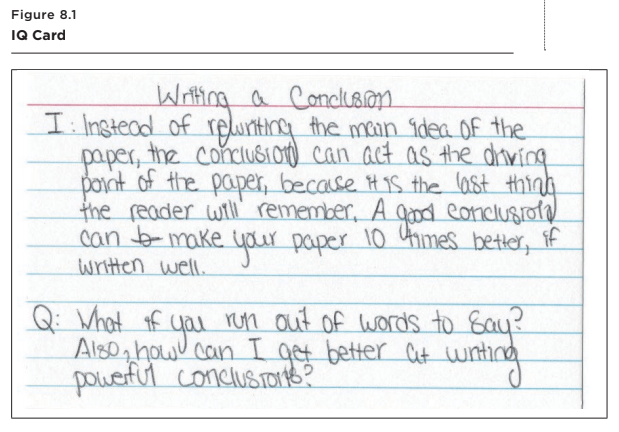IQ Cards (Insight & Question)
What It Is
IQ Cards allow all students to share two things: an insight (I) and a question (Q). They also allow all students to read one another’s insights and questions in a collaborative final step. These work well wtih difficult-to-test concepts that are measured by bigger-picture understandings. Examples might include historical conflicts and inequities, human responsibility, climate change, conservation, and controversial readings.
How It Works
- Using an index card, ask students to record one new and important insight that they gained from the lesson (tell them to be as specific as possible) and one question that they have about the content. Before they begin, let them know that others will be reading these cards, but will likely not know who wrote which I and Q. They should wait until the end of the activity to put their names on their cards.
- Ask students to take their card and stand in one large circle.
- Without reading it, ask students to hand the card (facing up) to the person on their right. Do that about four times, so that the identities of the writers are a bit more obscured.
- Once cards have been passed about four times, ask them to stop and read the card that they are holding in front of them.
- Once they finish reading the card, ask them to pass it to the person on their right.
- Tell them to keep reading and passing cards until they have their own card. Once they have their own card, they can stop and return to their seats and write their names on the backs of the cards.
- Whole Group: Address commonalities in the insights and address the common questions that students had.
- Ask students to put their names on their cards. Collect the cards, if you’d like to assess or monitor individual insights and questions.
How to Ensure Higher-Order Thinking
Rather than restating facts as their insights, ask students to think in terms of big-picture items. When you read the cards, make a special note of insights that were able to capture big-picture themes and revisit those during the whole-group time at the end, so that students have models of what big-picture items look like. You might say something like this: “Some of the big-picture insights that I recall reading touched on . . . ,” along with an explanation as to what made them big-picture insights. After they read their peers’ cards, ask them to record two new insights and a new question on the backs of their cards. Review some or all and return them to the students soon after they’ve been collected.

Source
Himmele P., and Himmele, W. Total Participation Techniques: Making Every Student an Active Learner. ASCD, 2017, pp.118-120.
